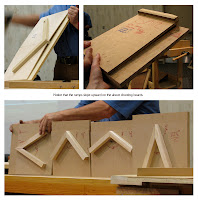My friend,
 Dyami Plotke
Dyami Plotke, sent a book to me entitled
"The Artistic Crafts Series of Technical Handbooks—Wood Carving: Design and Workmanship."It was printed in 1903 and focuses on relief carving—from choosing and sharpening tools to the do's and don'ts of the craft.
The author is very opinionated (alluding at one point to his distaste for a new trend in artwork which he finds to be without merit—presumably
Art Nouveau) and points continually to older artforms created in previous decades as objects worthy of study.
I love this book. The man who wrote it, George Jack, and I would never have gotten along. His "this is the correct and only way to do this" approach would drive me nuts. However, th

e language he uses and his instruction are excellent.
It's motivated me to try
relief carving again, so I spent time searching for a centuries-old print to use as a model. I found one on
Peter Follansbee's blog which depicts a cooper in 1485, tightening the hoops on an inverted bucket.
The artist had a wonderful eye for balance, negative and positive space, and format. Your eye is first attracted to the face and the central spot in the drawing—his workpiece—then your gaze moves down the cooper's body to the axe on the stump, then circles to the left to view the bucket, and sweeps back up to the hammer. This circular shape is underscored by the arch in the doorway.
Upon closer scrutiny, the seemingly crude sketch (in ink, I'm guessing) shows someone who, with use of minimal line, is able to suggest heavy, thick folds in cloth, and who had an eye for detail of a craft which he did not thoroughly know. Check out the shaving horse. It has a

dumbhead and footrest, but no bridge, and a gaping space in front of the dumbhead. Unless there was some insert (i.e., ramp or raised bed) that fit into the empty space, this shaving horse appears to be unusable. Plus, as Peter Follansbee pointed out, there is no front leg or pair of legs.
However, the artist does illustrate details like iron hoops hanging from the wall and a few of the tools a cooper would use. I was not able to determine two of the items on the rear table, to the left of his swinging hammer. One might be a cup because there is a pitcher nearby. The other looks like a pastry bag. Or corn cob. I opted to change those two objects to a drawknife and head shave.
Another thing I changed in my version are the parallel and horizontal lines. I used a plastic T-square and plywood triangle to square up the image. Those things can be fudged in sketches, but, to me, they would look sloppy in a carving.
What

makes this a nice piece to use for relief carving is the perspective. As Mr. Jack explains, the rules of perspective that apply to painting are not the same as those used in carving: "...all such features [in the artwork] must be treated in a way entirely different to that adopted by the painter—that is to say, in detached groups, each having some due relation to the original surface of the wood, and only very little to their perspective positions."
He goes on to say that objects that point directly toward the viewer, in severe perspective, simply will not work in relief carving.
The artwork that I have chosen to carve reflects this concept. The elements in the workshop seem to be stacked on top of one another, rather than drawn in realistic perspective, and are in lateral and 3/4 view.
Now, let's see if I can do this wonderful little painting justice.























































